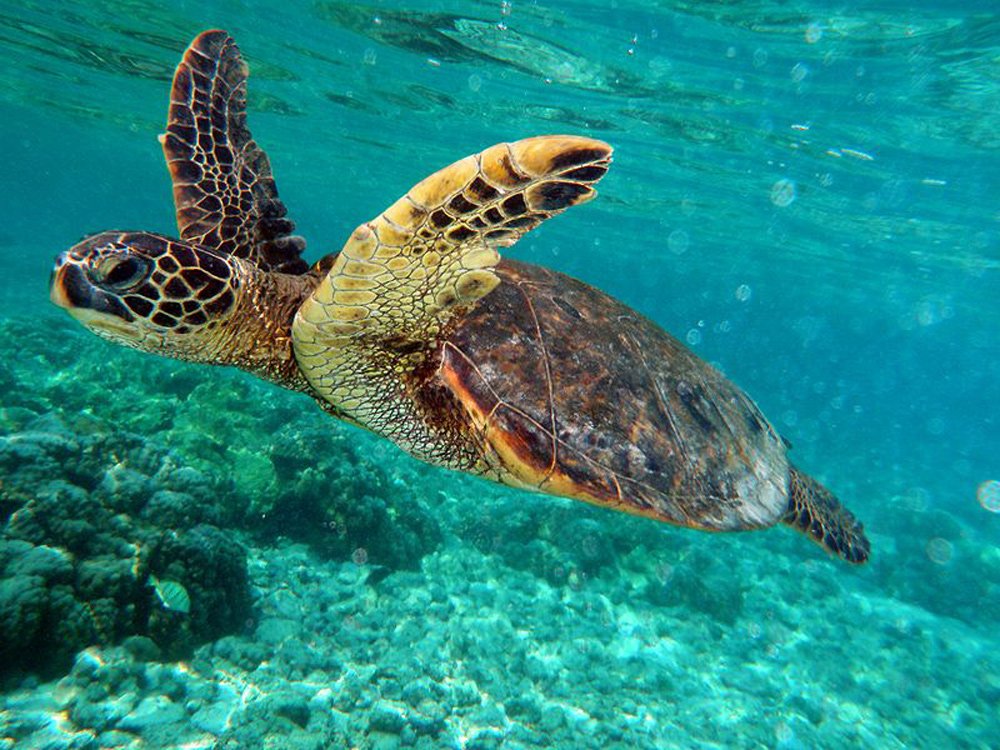Sea turtles in the Coral Sea
Six of the world’s seven sea turtle species – green, hawksbill, loggerhead, leatherback, flatback and olive ridley turtles, all endangered or vulnerable – visit the Coral Sea Marine Park.
Green turtles nest on its beaches and hawksbill turtles feed on its reefs. Others keep moving through the ocean on their long migrations.
“Green turtles are some of the most accomplished long-distance travellers on the planet.”
~ Professor Graeme Hays, Deakin University ~
Did you know?
- 3880 kilometres is the longest known green turtle migration through the Coral Sea, more than the entire width of Australia’s continent from Sydney to Perth.
- About 1 in 1000 sea turtle hatchlings survive to adulthood. Those that do survive have a lifespan of about 80 years.
- The exact temperature of the nest determines the sex of green turtle hatchlings: at or below 26°C, all males; at or above 29°C, all females; in between, some of both.
- Turtles have lived in the oceans for over 100 million years, since the time of dinosaurs. They are solitary creatures, travelling alone and rarely interacting. As cold-blooded reptiles, they can only survive in the tropics.
- Sea turtles spend most of their time underwater, but surface to breathe every 20 minutes or so. For longer dives lasting three hours or more, their heart rate slows radically to conserve oxygen.
Epic migrations
From the beaches where they hatch, baby turtles head straight for the ocean, not to be seen again until they appear in shallow waters to feed 2 to 10 years later. What happens during the ‘lost years’ and what determines their route is unknown.
As adults they migrate every few years to forage for food and to nest.
 Green turtle swimming over coral.
Green turtle swimming over coral.
The distances they travel vary widely between individuals, from less than 8 kilometres to more than 2000 kilometres.
How they navigate across such distances has not yet been determined. Recent research suggests they may use the sun, adjusting their direction with each sunrise.
The migration puzzle
Green turtles travel extreme distances between nesting and feeding grounds, but we don’t know why yet.
For example, individuals that nest in New Caledonia were found feeding on Heron Reef (Great Barrier Reef), while others that nest on nearby Heron Island were found feeding in New Caledonia.
Why did the Heron Reef nesters travel 1300 kilometres to feed when food was just as available on Heron Island? Could it have something to do with patterns set during the ‘lost years’?
Turtles are very good at keeping secrets, so this mystery remains unsolved.
Nesting on Coral Sea cays
To breed, female green turtles return to a beach near their own birthplace to mate in nearby waters and lay their eggs in the sand.
Large numbers of green turtles arrive between October and April to nest on the sandy cays of the Coral Sea Marine Park.
Outside these months their presence on the cays remains abundantly clear, as they leave behind large dug-out nests and tracks in the sand.
Discover more
Find out about:
- the Coral Sea
- the epic migrations of sea turtles.
Learn about your marine parks
Stay in touch
Subscribe to receive important updates about your marine parks. Enter your email address and click "join now".








